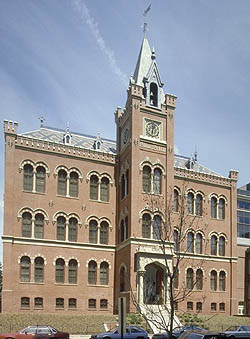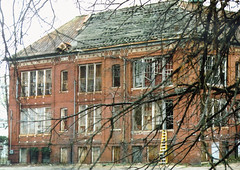Why is the investment concept foreign to municipal officials? Lease -- Not Sale -- of Public Assets!
In today's Post, Jack Newton of Alexandria reminds us in his letter to the editor, "Stadium Development: Lease Can Be More," that we need to think about the value of public assets from the standpoint of investments rather than looking for a quick, but ultimately paltry, buck.

Note the shocking thing that the DC Public Schools system did in the late 1980s. Rather than sell the land around (and) Sumner School, they offered it up on a 99 year lease. One of the lease requirements was that the developer not only rehabilitate Sumner School, but maintain it over the 99-year-period of the lease. So here is one DC municipally-owned property that is actually in sound condition, and doesn't have to grub for each dollar or defer maintenance
My joke is that the dominant property management paradigm of the District of Columbia government is "demolition by neglect."
 Sumner School. Designed by Adolf Cluss, renovated and maintained by Boston Properties. The building serves as the archives and a public meeting facility for the DC Public School System.
Sumner School. Designed by Adolf Cluss, renovated and maintained by Boston Properties. The building serves as the archives and a public meeting facility for the DC Public School System. Crummell School in Ivy City. Photo by Peter Sefton. (Through the efforts of Councilmember Graham, and the responsiveness of Office of Property Management director Carol Mitten, the roof has since been secured from the elements. Cost for basic rehabilitation is estimated as a minimum of $7.2 million.)
Crummell School in Ivy City. Photo by Peter Sefton. (Through the efforts of Councilmember Graham, and the responsiveness of Office of Property Management director Carol Mitten, the roof has since been secured from the elements. Cost for basic rehabilitation is estimated as a minimum of $7.2 million.)The Crummell School "property and site" is eagerly sought out by many developers, not to mention charter schools that enjoy preferred access to funds and uses over community-based interests.
Meanwhile the neighborhood has no public facilities, unless you count a facility for delinquent youth, a fleet management center for DC Government vehicles, and the soon-to-reopen vehicle inspection station. There is a recently renovated playground, but it is usually locked, and there are no provisions (last I heard) for providing an attendant.
Mr. Newton writes:
The 13 acres of land that the city and other government agencies own around the site of the District's proposed baseball stadium should not be sold to developers, but instead leased to them for 99 years.
Many large developments are built on 99-year leases for the land, with the buildings being transferred to the property owner at the end of the lease term (Skyline Towers in Falls Church is one example, I am told).
This land is the birthright of the residents of Washington, and it will be worth billions of dollars someday. As an economist, I suspect that the value of 99-year leases would compare favorably to the sale price. Have District officials studied this alternative?
_____
The "Growth Machine" isn't about making money for citizens, it's about making money for developers, and the Growth Machine is pretty well oiled in DC.



0 Comments:
Post a Comment
<< Home